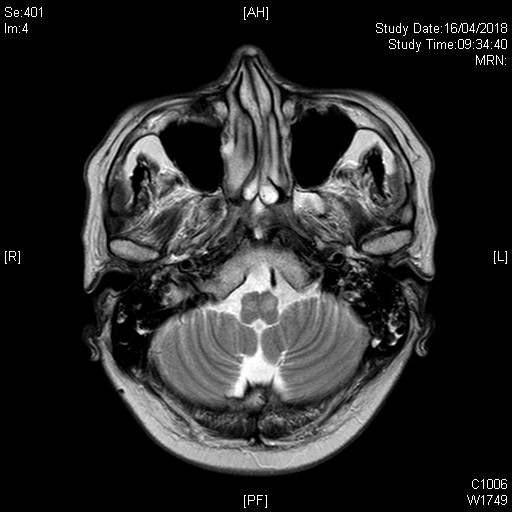Session Information
Date: Tuesday, September 24, 2019
Session Title: Tremor
Session Time: 1:45pm-3:15pm
Location: Les Muses Terrace, Level 3
Objective: To report a case of OPT as consequence of anti-GAD brainstem encephalitis
Background: OPT is caused by insult to the Guillain-Mollaret triangle. Common etiologies include brainstem haemorrhages or infarcts, cavernoma, trauma, or post irradiation. Anti-GAD (glutamic acid decarboxylase) is associated with a spectrum of disorders, including stiff person syndrome, cerebellar ataxia, limbic encephalitis, myoclonus, and temporal lobe epilepsy syndrome. However, brainstem dysfunction is less commonly reported.
Method: A 45 year old male presented in Oct 2017 with fever, bilateral horizontal gaze palsy and limb ataxia. MRI brain showed T2 hyperintense signal involving posterior pons and lower midbrain. CSF showed lymphocytic pleocytosis, but negative tuberculosis, bacterial, viral, fungal culture, cytology and oligoclonal band. He improved after pulse steroid. However, in Dec 2017, oral prednisone was rapidly tapered off due to steroid induced psychosis. In Jan 2018, he had recurrent brainstem encephalitis, presenting with impaired consciousness, impaired horizontal gaze, dysarthria, generalised weakness and ataxia. MRI showed extensive T2 hyperintense lesion involving posterior part of midbrain to medulla. He soon suffered from aspiration pneumonia requiring mechanical ventilation. After IVIG and pulse steroid, he regained full consciousness. In Feb 2018, there was rhythmic vertical oscillation of his eyes and soft palate, compatible with OPT. MRI brain in Apr 2018 showed inferior olivary nucleus hypertrophy and resolved T2 hyperintense signal in the rest of the brainstem (Figure 1).
Results: Patient was put on mycophenolate mofetil and tapering schedule of prednisolone to maintenance dose. Extensive test on autoimmune antibodies found positive serum anti-GAD. Whole body PET-CT did not reveal occult malignancy. He still had impaired horizontal gaze, limb ataxia and bulbar dysfunction requiring nasogastric tube feeding and tracheostomy. Besides, he suffered from troublesome opcillopsia. Treatment with gabapentin, memantine and clonazepam did not result in significant improvement.
Conclusion: Manifestations of anti-GAD include brainstem encephalitis. OPT occurs as a late consequence of insult to Guillain-Mollaret triangle. Ocular tremor causes oscillopsia, which is often difficult to treat. Treatment included gabapentin, memantine, baclofen, clonazepam, carbamazepine, valproate and levetiracetam.
References: 1) Caroline Tilikete and Virginie Desestret. Hypertrophic Olivary Degeneration and Palatal or Oculopalatal Tremor. Front. Neurol. 8:302. 2) M. Vianello, B. Tavolato, B. Giometto. Glutamic acid decarboxylase autoantibodies and neurological disorders. Neurol Sci (2002) 23:145–151
To cite this abstract in AMA style:
MF. Ip, SH. Li, TY. Wai, LY. Wong. Oculopalatal tremor (OPT) in a patient with anti-GAD brainstem encephalitis: A case report [abstract]. Mov Disord. 2019; 34 (suppl 2). https://www.mdsabstracts.org/abstract/oculopalatal-tremor-opt-in-a-patient-with-anti-gad-brainstem-encephalitis-a-case-report/. Accessed April 1, 2025.« Back to 2019 International Congress
MDS Abstracts - https://www.mdsabstracts.org/abstract/oculopalatal-tremor-opt-in-a-patient-with-anti-gad-brainstem-encephalitis-a-case-report/

